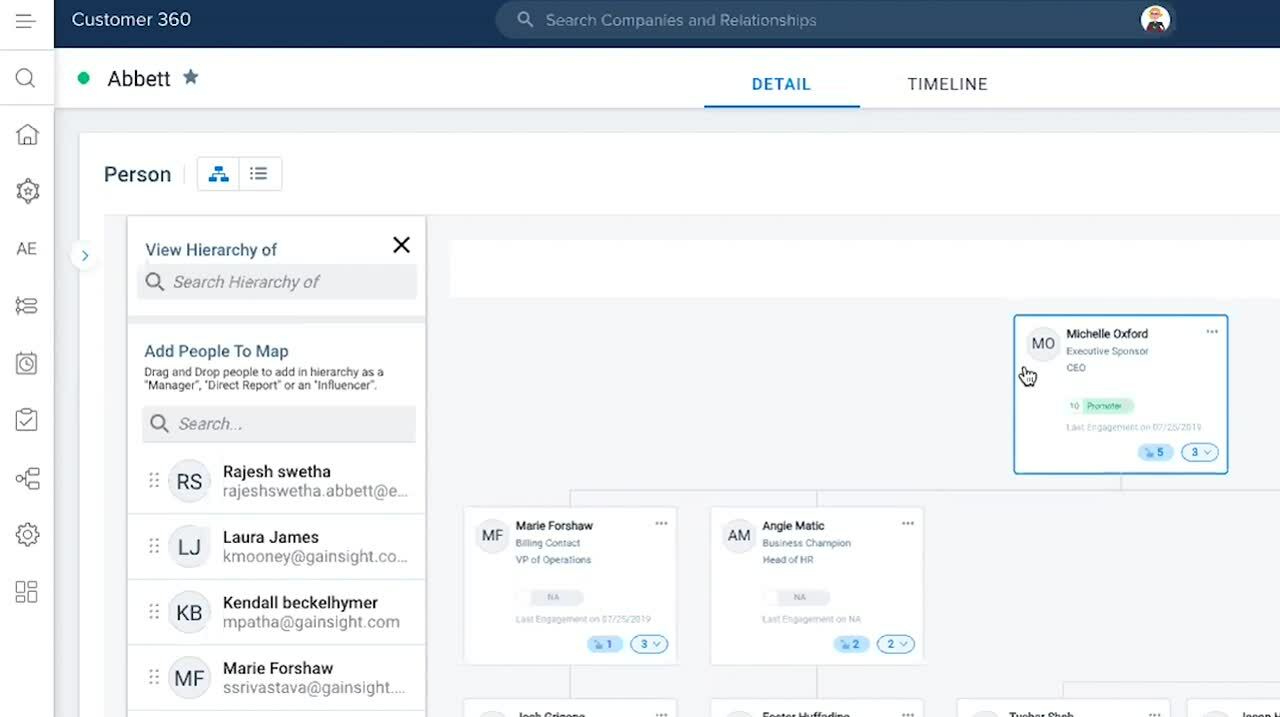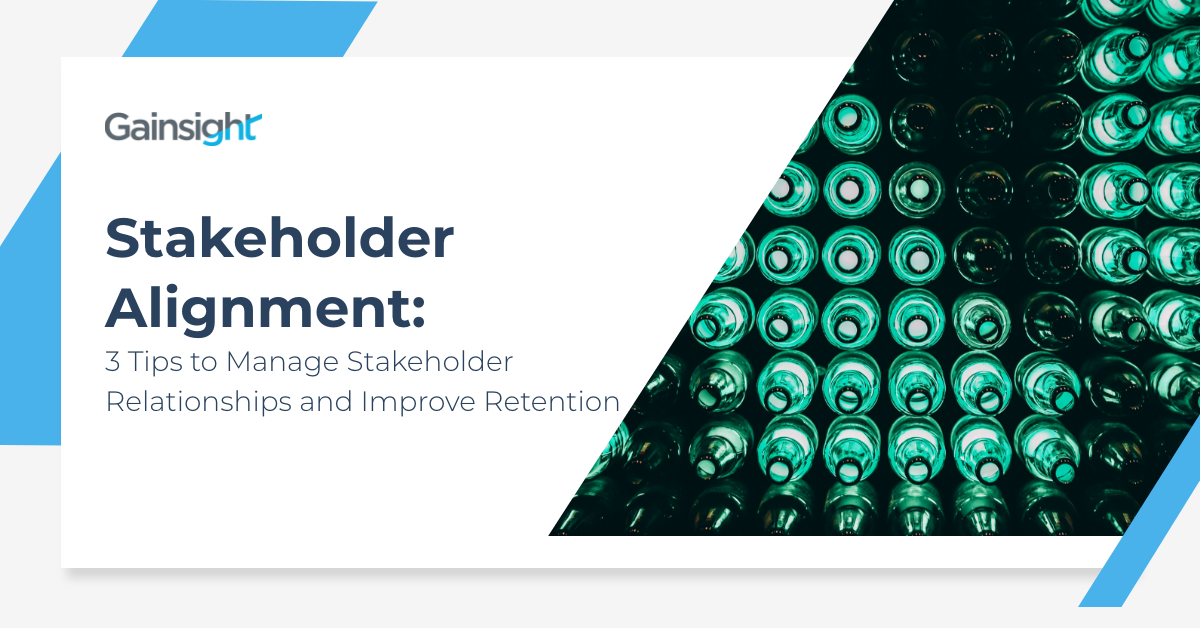In the world of customer success, it’s all about proving value, raising visibility, and understanding the customer, particularly in a time of fiscal “belt-tightening.” Suppose your customer, especially your executive stakeholders, don’t see the value your product or service gives them. What if you don’t understand their needs, goals, and desired outcomes.
When these situations happen, customer relationships can quickly become a churn hazard. It is mission critical that you, as a Customer Success (CS) leader or Customer Success Manager (CSM), connect with the customer where you comprehend why they purchased your product, what the goals were for its use, and get them to their outcomes. And they need to find value in your product quickly. Without that knowledge, sentiments change. However, if you can see and manage this, especially at the stakeholder level, you can take the right actions to ensure your accounts’ success.
Effective stakeholder management is a critical way to get greater visibility into your accounts. By engaging contacts in a more meaningful way, you can create more lasting relationships that ultimately improve retention and expansion. Here are three tips to flawlessly maintain stakeholder relationships and ensure customer retention.
Tip 1: Identify your stakeholders and key contacts
It may seem rudimentary, but even experts have to return to the fundamentals to remind them of the building blocks of what they want to accomplish. It’s essential in the relationship with customers to know who your key contacts are within an account. So, start with the basics.
- Who is your buyer—the individual who was ultimately responsible for purchasing your product or service? This could be Chief Executive Officer (CEO), Chief Financial Officer (CFO), Chief Operations Officer (COO), or even the Chief Customer Officer (CCO). It could also be a decision making Vice President, depending on the company. If they were critical to your buying decision, then they are critical to keeping your product.
- Who are the executive stakeholders involved in championing the purchase and supporting your product’s use? These will be sponsors who are typically Senior VPs or VPs of functions that advocate for your company and directly use your product or service.
- Expand your view to consider the influence of the Chief Information Officer (CIO), Operations leaders, and Systems Administrators, or other power users. One mistake that many CS teams make is narrowing a focus on high-level contacts or too few contacts in general. Remember, any effective stakeholder management strategy includes fostering engagement with a broad spectrum of stakeholders.
When you build a multi-threaded relationship within an account, it allows your team to raise your product and your company’s visibility. Then, as you deliver the outcomes your customer desires, you are cementing the relationship while driving retention and opportunities to expand. Most of all, it gives you a multi-level view into the challenges your customers face so you can offer better solutions and the potential to expand. Ultimately, you are creating multiple champions or advocates for your product with the organization so that if one leaves, your team isn’t left scrambling to demonstrate value to a new stakeholder.
Tip 2: Organize your stakeholders and surface key details
For some organizations, the most challenging part is not identifying your contacts but documenting them and making this information available to everyone that works with that customer account. When engaging with a client, you need a quick way to understand the “lay of the land” within their organization. That way, you can know all the right contacts to engage in specific situations.
Consider what would happen if your company did not have their contacts organized or have a central deposit of account information. It is not uncommon for contact data in a company’s CRM to be messy, out of date, contain duplicate data, or not have contact information at all. It is critical that, as a CS leader, your customer’s contact information is organized in a manner to view data in a more meaningful way.
Mapping out contacts’ organizational structure is an excellent way to understand the lay of the land within an account. While you are constructing a database of connections, you also can create an effective stakeholder management strategy. It will go beyond looking at the surface level organization structure to understand how contacts influence each other in that company.
Another bonus of organizing stakeholder information is that CS teams can input essential insights from their customer relationships. These account insights can be valuable assets for sales, executives, or anyone else engaging with customer stakeholders. This information can be:
- NPS scores, health scores, customer and CSM sentiment
- QBRs, EBRs, or merely the last time the contact engaged with your company
- Customer product usage, feature usage, goals, engagement levels, and outcomes, if any
Surfacing these attributes for every contact and providing them to everyone working with an account can enable your company to navigate engagements with key stakeholders more effectively.
At Gainsight, we operationalize this motion using a versatile feature called People Maps. Imagine a better collaboration between CS and Sales by creating a more unified view of customers and stakeholders. In People Maps, all customer-facing teams have the right insights they need to close renewals or expansion opportunities.

Click here to schedule a demo of People Maps.
Tip 3: Define Key Stakeholder Management Playbooks
Once you have gathered the stakeholder information and surfaced the needed insights, there is an additional step in the equation. An effective stakeholder management strategy requires you to engage and demonstrate value to them. Creating a standardized Playbook will help guide your team on the actions to take to drive alignment with key stakeholders. Here are a few examples of Playbooks that are good to have in your arsenal.
- Establishing executive alignment: If customer executives don’t value your product or service’s impact, that puts the account at risk for churn. Building and nurturing relationships between customers’ executives and your management enables you to reveal their goals and reinforce your value. This Playbook should include introductions, regular engagement, and performing executive business reviews (EBRs) to demonstrate the value your product delivers. It will help build and maintain relationships at the executive level, which drives retention and uncovers expansion opportunities.
- Protocols for Sponsor Change:When a customer champion gets promoted or leaves the company, your CSM usually isn’t the first to know. However, your CSM must respond quickly to avoid any potential risk the change could cause. Define a Playbook that proactively monitors company contact or sponsor changes and drives action quickly. For example, CSMs should try to connect with the new contact who will own your business relationship. In Gainsight, we do this using our Sponsor Tracking feature, which alerts CSMs of changes in a designated sponsor’s title, location, or company and then triggers a Playbook for the CSM to act.An additional benefit from the tracking sponsor changes is that it can lead to opportunities when your ex-sponsor moves on to a new company. In other words, quickly engage them after the change as a new prospect. The assumption is that they may be interested in bringing your product into their new company because they have been successful with it before.
- Response to Major Company News:Is any news good news? Yes! The more information you have, the better prepared you can be. When a significant story breaks or events that impact businesses happen, you need to know about them immediately, primarily when it involves your customer. Using a tool like Gainsight’s Company Intelligence can be beneficial to your stakeholder alignment strategy in this sense.
For instance, suppose your customer has a successful IPO or just had a lackluster earnings statement this quarter. The repercussions could be enormous, especially for your business. Easily inform your CSMs about “breaking news” related to your customer accounts and set a plan of action in motion to , proactively prepare for all changes.If you are looking to create a more effective strategy for managing stakeholders, having a Playbook for notifying your internal teams, and engaging the customer around important news is essential. Being in the know about a customer is a simple way to show them your investment in their success.
Tracking Your Progress
There is a saying—” What gets measured gets done.” Measuring the success of any stakeholder alignment strategy is a critical component of your business. Here are some examples of metrics to consider tracking:
- Operational: In Gainsight, you can record whenever one of your stakeholders has interacted with your company using the Timeline feature. Entries can be manual or automated based on the type of engagement, which meetings had executives present, events attended, or emails regularly opened. Another way to track stakeholder engagement is to have enabled regular sync up meetings using Calls To Action (CTA) as your reminder. Whenever a related CTA is closed successfully, it implies a completed stakeholder engagement.
- Account-level: Many customers have built an engagement health score using measures and activities described above. Relative thresholds can reflect both healthy and poor levels of stakeholder engagements. For example, suppose a customer decision-maker has not attended regularly scheduled meetings or has stopped opening your company emails. In that case, it indicates a potential risk, and the engagement score should be set accordingly.
- Business: Retention and expansion rates simply means, at the highest level, that your customer is staying and expanding. That is the best indication of stakeholder alignment.
To learn more about how Gainsight can help you build and mature your stakeholder alignment strategy, schedule a live demo of our Revenue Optimization products today.
